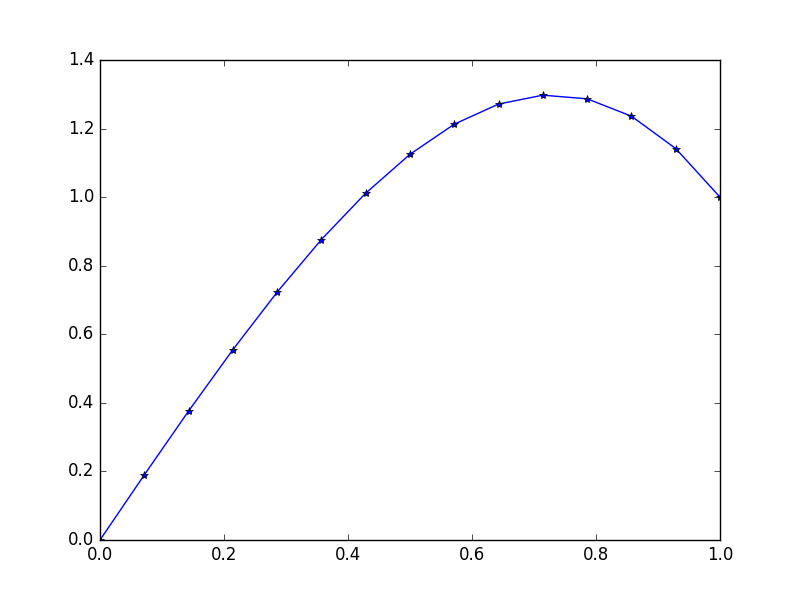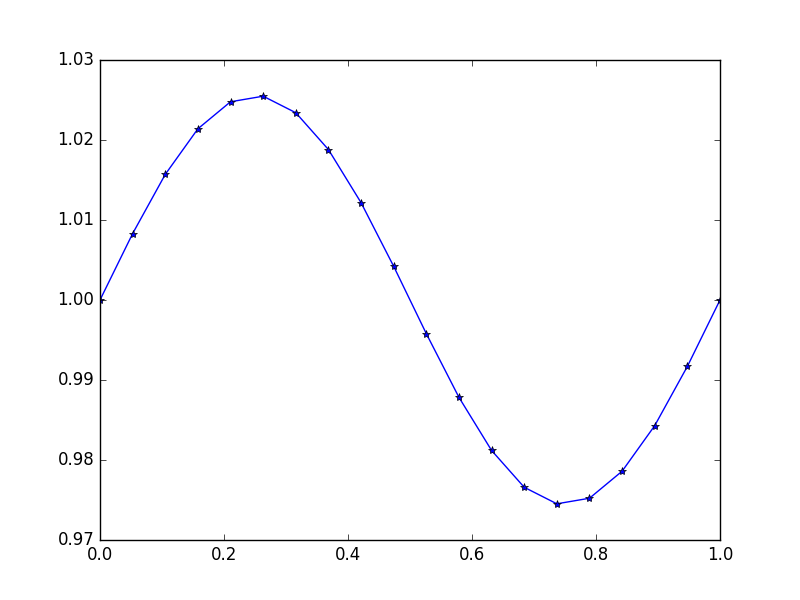#Introduction to Numerical Mathematics
Introduction to Numerical Mathematics
On a [0,1]\$[0,1]\$ domain, find a function u\$u\$ for given source function f\$f\$ and boundary values u_L\$u_L\$ and u_R\$u_R\$ such that:
-u'' = f\$-u'' = f\$u(0) = u_L\$u(0) = u_L\$u(1) = u_R\$u(1) = u_R\$
u''\$u''\$ denotes the second derivative of u\$u\$
This can be solved purely theoriticaltheoretically but your task is it to solve it numerically on a discretized domain x\$x\$ for N\$N\$ points:
- x =
{i/(N-1) | i=0..N-1}\$x = \{\frac i {N-1} : 0 \le i \le N-1\}\$ or 1-based:{(i-1)/(N-1) | i=1..N}\$\{\frac {i-1} {N-1} : 0 \le i \le N-1\}\$ h = 1/(N-1)\$h = \frac 1 {N-1}\$ is the spacing
###Input
Input
f\$f\$ as a function or, expression or stringu_L\$u_L\$,u_R\$u_R\$ as floating point valuesN\$N \ge 2\$ as an integer >=2
###Output
Output
- Array, List, some sort of seperatedseparated string of
u\$u\$ such thatu_i == u(x_i)\$u_i = u(x_i)\$
###Examples
Examples
Example 1
Example 1
Input: f = -2\$f = -2\$, u_L = u_R = 0\$u_L = u_R = 0\$, N = 10\$N = 10\$ (Don't take f=-2\$f=-2\$ wrong, it is not a value but a constant function that returns -2\$-2\$ for all x\$x\$. It is like a constant gravity force on our rope.)
There exists an easy exact solution: u = -x*(1-x)\$u = -x(1-x)\$
Example 2
Example 2
Input: f = 10*x\$f = 10x\$, u_L = 0\$u_L = 0\$, u_R = 1\$u_R = 1\$, N = 15\$N = 15\$ (Here there is a lot of upwind on the right side)
The exact solution for this states: u = 1/3*(8*x-5*x^3)\$u = \frac 1 3(8x-5x^3)\$
Input: f = sin(2*pi*x)\$f = \sin(2\pi x)\$, u_L = u_R = 1\$u_L = u_R = 1\$, N = 20\$N = 20\$ (Someone broke gravity or there is a sort of up- and downwind)
Here the exact solution is u = (sin(2*π*x))/(4*π^2)+1\$u = \frac {\sin(2πx)} {4π^2}+1\$
Input: f = exp(x^2)\$f = \exp(x^2)\$, u_L = u_R = 0\$u_L = u_R = 0\$, N=30\$N=30\$
Note the slight unsymmetryasymmetry
###FDM
FDM
- rewriteRewrite
-u_i'' = f_i\$-u_i'' = f_i\$ as (-u_{i-1} + 2u_i - u{i+1})/h² = f_i\$\frac {-u_{i-1} + 2u_i - u_{i+1}} {h^2} = f_i\$, which equals-u_{i-1} + 2u_i - u{i+1} = h²f_i\$-u_{i-1} + 2u_i - u_{i+1} = h^2 f_i\$- Setup the equations:

$$ u_0 = u_L \\ \frac {-u_0 + 2u_1 - u_2} {h^2} = f_1 \\ \frac {-u_1 + 2u_2 - u_3} {h^2} = f_2 \\ \dots = \dots \\ \frac {-u_{n-3} + 2u_{n-2} - u_{n-1}} {h^2} = f_{n-2} \\ u_{n-1} = u_R $$

$$ \begin{pmatrix} 1 & & & & & & \\ -1 & 2 & -1 & & & & \\ & -1 & 2& -1& & & \\ & & \ddots & \ddots & \ddots & & \\ & & & -1 & 2 & -1 & \\ & & & & -1 & 2 & -1 \\ & & & & & & 1 \end{pmatrix} \begin{pmatrix} u_0 \\ u_1 \\ u_2 \\ \vdots \\ u_{n-3} \\ u_{n-2} \\ u_{n-1} \end{pmatrix} = \begin{pmatrix} u_L \\ h^2 f_1 \\ h^2 f_2 \\ \vdots \\ h^2 f_{n-3} \\ h^2 f_{n-2} \\ u_R \end{pmatrix} $$
- Solve this equation and output the
u_i\$u_i\$
You may however use any other method to solve the Laplace equation. If you use an iterative method, you should iterate until the residual |b-Au|<1e-6\$|b-Au| < 10^{-6}\$, with b\$b\$ being the right hand side vector u_L,f_1h²,f_2h²,...\$u_L,f_1 h^2,f_2 h^2, \dots\$
###Notes
Notes
Depending on your solution method you may not solve the examples exactly to the given solutions. At least for N->infinity\$N \to \infty\$ the error should approach zero.
###Bonus
Bonus
###Winning




